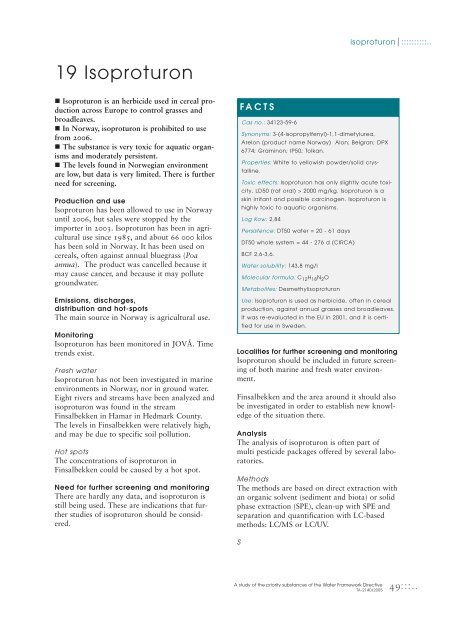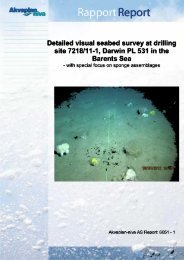A study of the priority substances of the Water Framework Directive ...
A study of the priority substances of the Water Framework Directive ...
A study of the priority substances of the Water Framework Directive ...
You also want an ePaper? Increase the reach of your titles
YUMPU automatically turns print PDFs into web optimized ePapers that Google loves.
19 Isoproturon<br />
� Isoproturon is an herbicide used in cereal production<br />
across Europe to control grasses and<br />
broadleaves.<br />
� In Norway, isoproturon is prohibited to use<br />
from 2006.<br />
� The substance is very toxic for aquatic organisms<br />
and moderately persistent.<br />
� The levels found in Norwegian environment<br />
are low, but data is very limited. There is fur<strong>the</strong>r<br />
need for screening.<br />
Production and use<br />
Isoproturon has been allowed to use in Norway<br />
until 2006, but sales were stopped by <strong>the</strong><br />
importer in 2003. Isoproturon has been in agricultural<br />
use since 1985, and about 66 000 kilos<br />
has been sold in Norway. It has been used on<br />
cereals, <strong>of</strong>ten against annual bluegrass (Poa<br />
annua). The product was cancelled because it<br />
may cause cancer, and because it may pollute<br />
groundwater.<br />
Emissions, discharges,<br />
distribution and hot-spots<br />
The main source in Norway is agricultural use.<br />
Monitoring<br />
Isoproturon has been monitored in JOVÅ. Time<br />
trends exist.<br />
Fresh water<br />
Isoproturon has not been investigated in marine<br />
environments in Norway, nor in ground water.<br />
Eight rivers and streams have been analyzed and<br />
isoproturon was found in <strong>the</strong> stream<br />
Finsalbekken in Hamar in Hedmark County.<br />
The levels in Finsalbekken were relatively high,<br />
and may be due to specific soil pollution.<br />
Hot spots<br />
The concentrations <strong>of</strong> isoproturon in<br />
Finsalbekken could be caused by a hot spot.<br />
Need for fur<strong>the</strong>r screening and monitoring<br />
There are hardly any data, and isoproturon is<br />
still being used. These are indications that fur<strong>the</strong>r<br />
studies <strong>of</strong> isoproturon should be considered.<br />
isoproturon ::::::::::..<br />
Localities for fur<strong>the</strong>r screening and monitoring<br />
Isoproturon should be included in future screening<br />
<strong>of</strong> both marine and fresh water environment.<br />
Finsalbekken and <strong>the</strong> area around it should also<br />
be investigated in order to establish new knowledge<br />
<strong>of</strong> <strong>the</strong> situation <strong>the</strong>re.<br />
Analysis<br />
The analysis <strong>of</strong> isoproturon is <strong>of</strong>ten part <strong>of</strong><br />
multi pesticide packages <strong>of</strong>fered by several laboratories.<br />
Methods<br />
The methods are based on direct extraction with<br />
an organic solvent (sediment and biota) or solid<br />
phase extraction (SPE), clean-up with SPE and<br />
separation and quantification with LC-based<br />
methods: LC/MS or LC/UV.<br />
S<br />
FACTS<br />
Cas no.: 34123-59-6<br />
Synonyms: 3-(4-isopropylfenyl)-1,1-dimetylurea,<br />
Arelon (product name Norway) Alon; Belgran; DPX<br />
6774; Graminon; IP50; Tolkan.<br />
Properties: White to yellowish powder/solid crystalline.<br />
Toxic effects: Isoproturon has only slightly acute toxicity,<br />
LD50 (rat oral) > 2000 mg/kg. Isoproturon is a<br />
skin irritant and possible carcinogen. Isoproturon is<br />
highly toxic to aquatic organisms.<br />
Log Kow: 2,84<br />
Persistence: DT50 water = 20 - 61 days<br />
DT50 whole system = 44 - 276 d (CIRCA)<br />
BCF 2,6-3,6.<br />
<strong>Water</strong> solubility: 143,8 mg/l<br />
Molecular formula: C 12 H 18 N 2 O<br />
Metabolites: Desmethylisoproturon<br />
Use: Isoproturon is used as herbicide, <strong>of</strong>ten in cereal<br />
production, against annual grasses and broadleaves.<br />
It was re-evaluated in <strong>the</strong> EU in 2001, and it is certified<br />
for use in Sweden.<br />
A <strong>study</strong> <strong>of</strong> <strong>the</strong> <strong>priority</strong> <strong>substances</strong> <strong>of</strong> <strong>the</strong> <strong>Water</strong> <strong>Framework</strong> <strong>Directive</strong><br />
TA-2140/2005<br />
49:::..

















